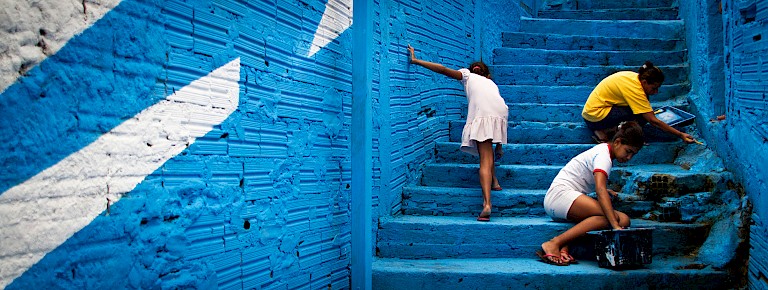



"We actively involved the community in the process of creation of the works,” says Pablo Ferreiro of Boa Mistura. “The impact is incredibly strong, because they became co-authors of the piece.” Working with families in the neighborhood, the artists soon became fascinated by the winding “alleys,” designed for foot traffic, that wend crookedly through the neighborhood. The team found them to be defining elements of the neighborhood—not only because they are a primary architectural feature, but because they figure largely in the communal life of the district.
In conversations with community members, several words emerged as important values shared by residents: Beleza, Firmeza, Amor, Doçura, and Orgulho, which translate to beauty, strength, love, sweetness, and pride. The overhanging walls, which interconnect in a complicated geometry unlike a city built on a grid, suggested an approach that capitalized on the planes to create an optical illusion.
Enlisting hundreds of local children to help, the team first painted bright, flamboyant colors on walls and walkways. Then the words were painted in such a way that only at certain locations would they be legible. While complicated in terms of perspective, the project resulted in simple, bold paintings.
“The project gave a new identity for the favela’s streets,” says Ferreiro. “It gave the inhabitants a new perspective of their community and reinforced the sense of group identity among the neighbors.” For those outside of the favelas, Ferreiro says, the project serves as a reminder that a seemingly “run-down” community has “strong and positive values.” Finally, and perhaps most importantly, the project, in enlisting hundreds of children to help, “encouraged the community kids to chase their dreams and make them true.”
The aesthetic of the project hints at the work required in such a chase. By avoiding traditional representational murals in favor of cleverly situated words floating in color, the collective forces new meaning from the crooked streets of the favelas. Instead of cramped, dangerous, confusing, or unsanitary, the streets reveal ingenuity and surprise. The first step in achieving strength, the project implies, is to simply adopt the right perspective.
All copyright belongs to Shanghai Academy of Fine Arts, Shanghai University.



